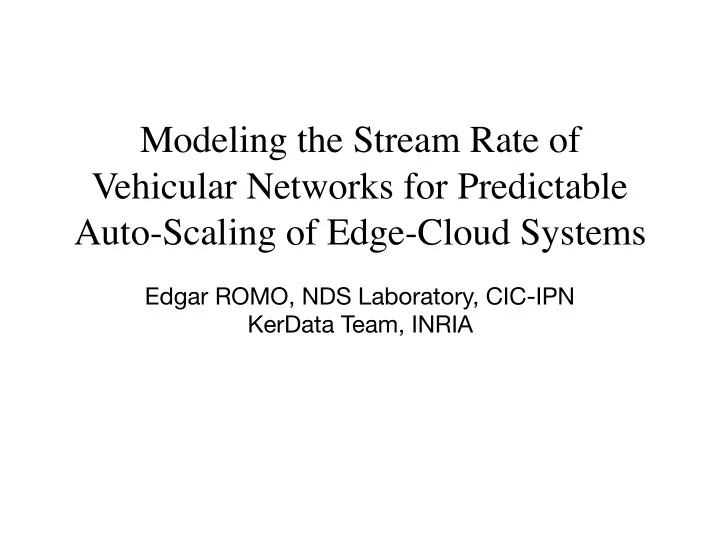

Modeling the Stream Rate of Vehicular Networks for Predictable Auto-Scaling of Edge-Cloud Systems Edgar ROMO, NDS Laboratory, CIC-IPN KerData Team, INRIA
Introduction • Context: Vehicular Networks connected to the Cloud Resources for APP x • Objective: take advantage of the Edge and Cloud processing Or capabilities e ffi ciently • Use-case: auto-scaling for Edge- Cloud architectures Current In the furute
Goals • Modeling the stream arrivals rate • Use of Edge Services to predict the load of information to be processed • Making a more realistic prediction using Coxian distributions • Mathematical model for arrival of information • Designing an Auto-Scaling module to reserve resources in the Cloud • Reduction the amount of information processed in the Cloud
Vehicular Networks * Taken from Le Liang, Toward Intelligent Vehicular Networks: A Machine Learning Framework
Prediction of the arrivals • Classical arriving/service time model for networks based on queue theory • Usage of exponential distribution to model times of service
Prediction of the arrivals • Another approach is to see like a black box where vehicles enters and travel inside a coverage area • Inside the coverage area, di ff erent situations could occur
Prediction of the arrivals • Predicting model based on tra ffi c lights • Coverage area where vehicles move inside it by a random time
Prediction of the arrival • Although multiple random variables with exponentials distribution are considered, the time inside the coverage area is not a exponential distribution
Assumptions • Vehicles move inside the coverage area only over the rails • Each rail is seen as a queue • There are two kind of queues : • In: Those are entrances to the coverage area • S: Those are the rails which connect to di ff erent tra ffi c lights • Arrivals are following an exponential distribution with mean 1/ λ • Semaphores change between red and green light following a random exponential distribution with mean 1/ γ • Vehicles only move to other place in case of green light and after a random time exponentially distributed with mean 1/ μ
Movement of the vehicles more similar to real life
Distribution of times inside the coverage area
Why prediction is important • If the time of permanence in the system is know, it could be possible to know the load of information that needs to be processed • In order to have a mathematical model of the times inside the system, Coxian distribution is though to be used • The challenge is find the set of parameters of Coxian distribution that suit the behavior of vehicles • The model of prediction, is a key point for the Auto- scaling module
System architecture • Vehicle to infrastructure network model • Edge processing capabilities • Edge Client1 • Prediction DATA • Cloud EDGE • Scaling CLOUD Mobile device
Auto-scaling module Auto-scaling module Arrival rate sensed by Base Station Prediction model: f( ! ) -> Time of service ! (Ts ) Output: Resources to be # resources Application in reserved: to be f(bp, cap_res)= reserved use, packet size Load of bits: f(Ts, Ps) -> bits to bp/cap_res = ( ps ) process (bp) # resources *cap_res = Capacity of each resource
Use of Edge-Cloud architecture • Two approaches: • Prediction made in the Edge, process as much as possible in the Edge and reduce services required from Cloud • Prediction made in the Cloud, reserve services in the Cloud
Increase servers SENSED PREDICTION DATA OF # OF PACKETS Client1 IN FUTURE PREDICTION Drecrease servers EDGE CLOUD Mobile VS device Increase servers Client1 SENSED DATA PREDICTION OF # OF PACKETS IN FUTURE Drecrease servers EDGE Mobile CLOUD device
Benefits of Edge-Cloud Auto-scaling • Knowing the arrival rate to the system, the prediction model estimate the time that vehicles are inside of the system • Based on the size of packages and the rate of them, (kbps), the load of information is computed • The work load for a period of time is computed • Cloud resources are reserved based on the work load
Next steps • Use of a real Edge-Cloud architecture to be deployed over the Grid5000 • Compare performance of prediction • Install the prediction module in the Edge and in the Cloud in two separate experiments. • Compare the accuracy of predictions in Edge against in Cloud
Expected results • The model is more realistic to real world • The model could be easily extended to other use-cases • The prediction made in the Edge is more e ffi cient than in the Cloud • Latency could be reduced
Recommend
More recommend